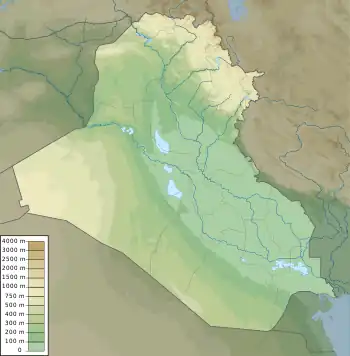Haradum
Haradum (modern Khirbit ed-Diniye (also Khirbet ed-Diniyé), in Al Anbar Governorate Iraq, was an ancient Near East city on the middle Euphrates about 90 kilometers southeast of Mari. It was part of the ancient region of Suhum. The name of the town meant "the place where one stands watch".[1]
 Shown within Iraq | |
| Alternative name | Khirbit ed-Diniye |
|---|---|
| Location | Al Anbar Governorate, Iraq |
| Coordinates | 34.433333°N 41.600000°E |
| Type | settlement |
| History | |
| Founded | Early 2nd millennium BC |
| Periods | Bronze Age |
| Site notes | |
| Excavation dates | 1981-1988 |
| Archaeologists | Christine Kepinski-Lecomte |
| Condition | Ruined |
| Ownership | Public |
| Public access | Yes |
History
While the site of Haradum was occupied earlier, under the control of Eshnunna, being mentioned in texts from Mari, [2] After a hiatus it grew into a proper town until the 18th century BC under the control of the First Dynasty of Babylon. It was later the site of a Neo-Assyrian fortress.
Babylonian period
The earliest dated record is from the 26th year of King Samsu-iluna of Babylon. Tablets from the reign of Babylonian rulers Abi-eshuh, Ammi-ditana, Ammi-saduqa, and Samsu-Ditana have also been found at Haradum.
Haradum is noted for being one of the earliest examples of a planned city, with a rectilinear layout and straight streets. It contained two temples (dedicated to Ishtar and Adad respectively) but no palace.[3]
Archaeology
The site of Haradum is small, about 1.5 hectares in area (a 150 by 150 meter square) with a fortification wall having a main gate in the western wall. It was excavated for six seasons between 1981 and 1988 by a team from the Délégation Archéologique Française en Iraq led by Christine Kepinski-Lecomte. A number of cuneiform tablets were found in residential and temple contexts. The work was a salvage operation in response to Haditha Dam construction.[4][5][6][7]
The excavators found four 2nd Millennium BC building layers. The first (3D) was from the time of Mari ruler Zimri-Lim (1775–1761 BC) and included a fortification wall. Later construction followed the street plan established at that time. The subsequent levels, under Babylonian and later Middle Assyrian rule dated c. 1750-1700 BC (3C), c. 1700-1665 BC (3B) destroyed by fire, and c. 1665-1130 BC (3A). Part of the later was overlaid by the Neo-Assyrian fortress.[8][9][10]
References
- Kepinski, Christine, "Organization of Harrâdum, Suhum, 18th–17th Centuries b.c., Iraqi Middle Euphrates", Organization, Representation, and Symbols of Power in the Ancient Near East: Proceedings of the 54th Rencontre Assyriologique Internationale at Würzburg 20–25 Jul, edited by Gernot Wilhelm, University Park, USA: Penn State University Press, pp. 143-154, 2022
- Wolfgang Heimpel, "Letters to the King of Mari", Eisenbrauns, 2003 ISBN 1-57506-080-9
- C.Kepinski-Lecomte, "Spatial occupation of a new town Haradum", in Houses and Households in ancient Mesopotamia. K.R. Veenhof (ed.); Leiden: Nederlands Historisch-Archaeologisch Instituut te Istanbul, pp. 191-96, 1996
- Christine Kepinski and Olivier Lecomte, "Mari et Haradum", Mari Annales de Recherches Interdisciplinaires, vol. 4, pp. 615-621, 1985
- Christine Kepinski and Olivier Lecomte, "Haradum/Harada, une forteresse sur l'Euphrate", Archeologia, vol. 205, pp. 46-55, 1985
- F. Joannes, C. Kepinski, and O.Lecomte, "Présence babylonienne dans le pays de Suhu au XVIIe siècle av. J.-C: L'exemple de Kherbet ed Diniye, Iraq", Revue d'assyriologie d'archéologie orientale, vol. 77, pp. 119-142, 1983
- F. Joannes, "Haradum et le pays de Suhum", Archeologia, vol. 205, pp. 56-59, 2005
- "Excavations in Iraq, 1981-82", Iraq, vol. 45, no. 2, pp. 199–224, 1983
- "Excavations in Iraq, 1983-84", Iraq, vol. 47, pp. 215–39, 1985
- "Excavations in Iraq 1987-88", Iraq, vol. 51, pp. 249–65, 1989
Further reading
- D. Charpin, "Les pouvoirs locaux à l’époque paléo-babylonienne : le cas du maire et des Anciens de Harrâdum", dans S. Dönmez (dir.), DUB.SAR E.DUB.BA.A., Studies Presented in Honour of Veysel Donbaz / Veysel Donbaz’a Sunulan Yazılar, Istanbul, pp. 41-54, 2010
- D. Charpin, "Harrâdum, entre Babylone et le “pays de Mari”", dans E. Cancik-Kirschbaum, J. Klinger et G.G.W. Müller (dir.), Diversity and Standardization, Perspectives on social and political norms in the ancient Near East, Berlin, pp. 27-48, 2013
- Mark W. Chavalas, "Terqa and Haradum: A Comparative Analysis of Old Babylonian Period Houses Along the Euphrates" in The 90th Anniversary Volume of the Archaeological Institute of America, St. Louis Chapter, ed., A. Dempsey (St. Louis: Archaeological Institute of America, St. Louis Chapter, 1997
- Christine Kepinski-Lecompte, "Haradum I: Une ville nouvelle sur le Moyen-Euphrate", Editions Recherche sur les Civilisations, 1992, ISBN 2-86538-229-X
- F. Joannes, C. Kepinski-Lecompte, Gudrun Colbow, "Haradum II. Les Textes de la Periode Paleo-Babylonienne (Samsu-iluna - Ammi-saduqa)", ERC, 2006, ISBN 2-86538-311-3
- C. Kepinski, "Haradum III : Haradu, forteresse du moyen Euphrate iraquien (XIIe-VIIIe s. av. J.-C.)", Paris, 2012
- C. Kepinski, "Material Culture of a Babylonian Outpost on the Iraqi Middle Euphrates: the Case of Haradum during the Middle Bronze Age", Akkadica, vol. 126, pp. 121–131, 2005
- C. Kepinski, "La conquête du pays de Suhum par le royaume d’Eshnunna et les liens tribaux entre la Diyala, la Mésopotamie du sud, la péninsule arabique et la vallée du moyen-Euphrate", dans Baghdader Mitteilungen 37, pp. 117-130, 2006
- Sauvage, Martin, "Le Contexte Archeologique et la Fin des Archives a Khirbet Ed-Diniye — Haradum", Revue d’Assyriologie et d’archéologie Orientale, vol. 89, no. 1, pp. 41–55, 1995
